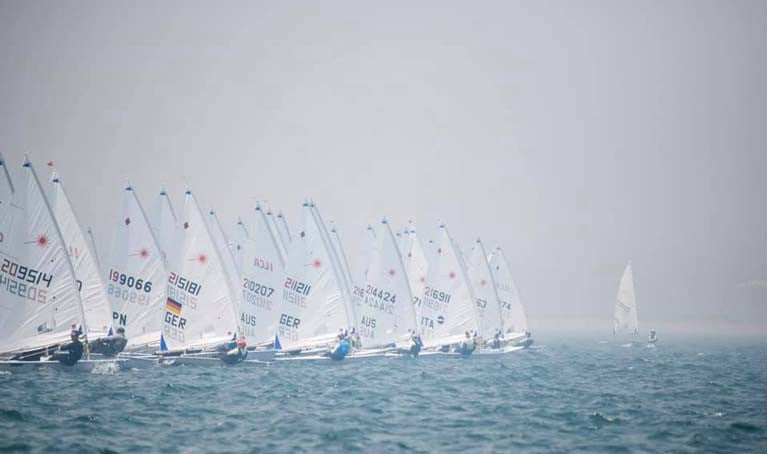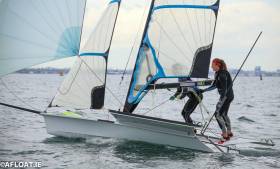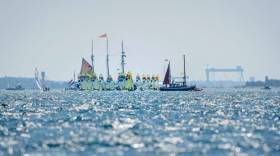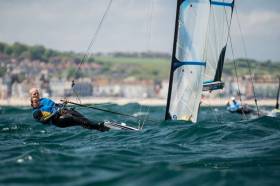Displaying items by tag: Annalise Murphy
Laser Radial Star Annalise Murphy on Form at Sail Melbourne
Annalise Murphy's heavy air prowess is to the fore at Sail Melbourne this week where the Rio Olympic silver medalist is enjoying her second regatta since her return to the Radial for a Tokyo 2020 bid.
The National Yacht Club's Murphy won the one and only race today and moved up into fifth place overall and third-ranked female.
Despite a huge storm front battering Port Phillip in the early afternoon, most classes were able to complete a full slate of racing on day three of the 2020 Sail Melbourne International Regatta today.
The thick squall carried a sheet of small hailstones and hit the bay just as most of the racing was wrapping up with the Laser, Laser Radial and Laser 4.7s the only fleets restricted to one race. Two days remain in most of the fleets with only the Tasar fleet deciding the winners today.
Rio Olympic champion Marit Bouwmeester continues to lead the female rankings after an eighth-place today with Italy’s Rio Olympian Silvia Zennaro following in second after posting a second.
“It was a nice day, but it took a bit long to get started. I think it took them an hour and 15 minutes to get the guys on the way, and then even the 4.7s had a general recall so it was a long day on the water for only one race and that was a shame. But it was good and it’s nice to be here and get some racing in,” Bouwmeester said.
Ireland's three other competitors in Melbourne are Aoife Hopkins 22nd, Aisling Keller 39 and Eve McMahon 56. Results are here
Annalise Murphy Shows Form in Return to Radial Tokyo 2020 Competition in Melbourne
Rio Olympic silver medallist Annalise Murphy marked her return to the Laser Radial with some reliable performances at the Australian National Championships in Melbourne this week. Her scoresheet included a race win as David O'Brien reports in this morning's Irish Times Sailing column here.
Next up for four Irish sailors, including Murphy, in the only Irish boat qualified so far for Tokyo 2020, is an Olympic trial series starting in March.
Much more in the Irish Times here.
Rio Silver Medalist Annalise Murphy is recording some encouraging results at the Australian Laser National Championships this weekend.
In one of her first major regattas since returning to the Laser last September, in a bid for the Irish Tokyo slot, the National Yacht club star is the top Irish woman from four contesting the championships at the Sandringham Yacht Club in Melbourne.
Murphy has counted a race win but also a black flag penalty to be placed 19th overall so far in the championships that have featured strong and light winds and some 'chilly' conditions.
The Men's and Women's Laser Radial classes are sailing together, split into Yellow and Purple fleets.
With the Australian selection for Tokyo 2020 still to be decided, Queenslander Mara Stransky struck an early blow with two wins in Purple fleet. Yumiko Tombe of Japan was second and Marie Burrue (FRA) was third in the first race. All three were pleased to have beaten Rio 2016 gold medallist, Marit Bouwmeester, who finished fifth overall and fourth woman.
Murphy's rivals for the Tokyo berth (that will be decided in selection trials later this year) are all sailing in the gold fleet and currently placed as follows: Aoife Hopkins 32nd, Aisling Keller 37th and Eve McMahon 60th.
The championships were subject to a protest by a competitor under 'Air quality' but the complaint was dismissed.
Results here
Annalise Murphy Confirms Return To Laser in Bid for Tokyo Olympic Gold
Annalise Murphy faces a three-way trial for Irish selection before she can race for gold at Tokyo 2020. Ireland's Olympic Silver Medallist confirmed her return to the Laser Radial class tonight with 300 days to go to the Olympic Regatta.
The widely expected decision follows last week's announcement that she had quit her 49erFX campaign with Katie Tingle.
Murphy’s return to the class will meet domestic competition from Aoife Hopkins and Aisling Keller who have already qualified Ireland for a place in the Radial discipline as described by Irish Times Sailing Correspondent David O'Brien here.
The three female solo sailors will race in an open trial using a number of international regattas to determine which candidate is nominated to represent the nation in Tokyo.
"I've already been sailing the Radial and feel fresh in the boat and I'm really excited to be back"
The do-or-die series will start in the Spring of 2020 and will use the combined scores from each of three European regattas; Palma in March, the World Cup in Genoa in April and Hyeres Regatta in late April to decide the nomination.
Murphy acknowledged the challenge ahead saying "with trials starting early next year there is a lot of work to get through, however, I've already been sailing the Radial and feel fresh in the boat and I'm really excited to be back"
Irish Sailing Head Coach Rory Fitzpatrick added “Having coached Annalise up to the Rio Olympics it makes her transition into the Laser Radial squad pretty easy. Having Annalise back in the class will raise the standard for everyone”.
'Disappointed' Annalise Murphy Quits Olympic 49erFX Campaign & Expected to Return to Radial for Tokyo Trial
Olympic Silver medalist Annalise Murphy is expected to return to the Laser Radial dinghy immediately after abandoning hopes of a final qualification chance in the 49erfX dinghy she has been campaigning with Katie Tingle for Tokyo 2020.
After a 'hugely challenging' fourteen months for Murphy and Tingle in the 49erFX class, it was decided after the summer that their 'Olympic medal goal' was no longer realistic, and the campaign has now come to an end.
While Murphy's plans have ended in the 49erFX, all is not lost for Irish Skiff fans, however, who can be certain that Royal Irish sailor Saskia Tidey of Dun Laoghaire will make the British team for Tokyo having won a Bronze medal in September's Pre-Olympics.
Annalise Murphy, a two time Olympian (finishing fourth and second respectively), reflected on the summer performances and in 'consultation with stakeholders' decided against continuing in the 49erFX. Katie Tingle, who has given '100% to the campaign' understands Annalise’s viewpoint but is nevertheless disappointed that the campaign is ending. Commenting on the situation Katie Tingle said “of course I’m disappointed. I’ve had a roller coaster fourteen months having jumped straight in at the deep end of high-performance sport. It’s been incredible seeing how hard everyone works for their goal and the support that goes around it, I’ll miss my teammates and all the support staff.”
 Annalise Murphy and Katie Tingle in training on Dublin Bay Photo: Afloat
Annalise Murphy and Katie Tingle in training on Dublin Bay Photo: Afloat
After a long period of training that was prefaced by injury in September 2018 when Tingle broke her arm in training on Dublin Bay, the duo first raced in April 2019 at the World Cup in Genoa and immediately admitted a steep learning curve, finishing in the silver fleet. A month later they retired from two races at the Europeans Championships in Weymouth. There appeared to be some progress in June at Kiel Week but by August and a trip to Tokyo for the pre-Olympics, and more mid-fleet results, it appears the writing was on the wall.
"I guess the World Cup in Japan was a bit of a wakeup call for me"
In a statement released this afternoon, Irish Sailing team managers say 'Annalise and Katie are lifelong friends and the decision was not made lightly'.
Murphy said “I guess the World Cup in Japan was a bit of a wakeup call for me, I was unable to see a medal in less than twelve months and that was always the goal. Katie has been incredibly understanding in what is clearly a difficult situation. I’ve learned so much from her over the last fourteen months and am glad our friendship has grown from this shared experience.”
The statement says Murphy is now going to take some time to consider her next steps. With the Laser Radial qualified for an Irish place in the Tokyo 2020 Olympics, it would seem very likely that she will be back on the water soon.
Irish Sailing Performance Director James O’Callaghan commented, “the Irish Sailing 49erFX project has benefitted the whole team, to have people as positive as Annalise and Katie in the programme has inspired the other teams. We now have a second FX campaign in its infancy so their legacy will continue. Katie took the opportunity to explore her potential to follow her dream, she made the most of the chance and I hope can look back fondly on the experience.”
A five and a three scored in today's 49erFX races at Kiel Week, Germany represents a significant performance improvement for Annalise Murphy and Katie Tingle who had been languishing in 41st place from 53 after day one.
The result moves the pair –who are four regattas into a 2020 Olympic campaign – up a dozen places overnight and into the top thirty overall in 29th.
The National Yacht Club and Royal Cork Yacht Club combination are using Kiel as part of their overall bid for Tokyo Olympic qualification later this year.
Results are here
Annalise Murphy and Katie Tingle are 41st from a fleet of 53 after the first three 49erFX races of Kiel Week regatta, Germany yesterday.
The National Yacht Club and Royal Cork Yacht Club combination scored 17, 20 and 18 in their opening rounds of the seven race series. Participation this week is part of their overall bid for Olympic qualification later this year.
Reigning World Champions, Annemiek Bekkering and Annette Duetz of the Netherlands hold the lead with Swedes holding second and third places in the 49erFX fleet.
Vilma Bobeck and Malin Tengström are about to contest the 49erFX Junior World Championships in Norway yet are proving they are world-class performers at the senior level, currently second in Kiel ahead of their teammates Klara Wester and Rebecca Netzler. As if that wasn’t enough Swedish dominance, Julia Gross and Hanna Klinga are in fifth place overall after a windy first day on the water.
Results are here
Annalise Murphy and Katie Tingle compete in the 49erFX dinghy at the Kieler Woche regatta in Kiel, starting this Wednesday 26th June. It will be their third major international regatta in a bid for Tokyo 2020 qualification later this year.
A baptism of fire left the Dublin Cork duo with a 'steep learning curve' after a World Cup debut in Genoa in April, the pair also finished in the silver fleet at the European Championships in May.
Kiel, therefore, will be a gauge of the duo's progress over the past six weeks in preparation for the bigger goal of the Olympic qualifiers in Auckland, New Zealand at the end of November.
Kieler Woche, one of the world’s biggest sailing events, attracts more than three million visitors each year and is celebrating its 125th anniversary this year.
Also entered for Kiel Week is Annalise's Team Rio 2016 teammate Saskia Tidey of the Royal Irish Yacht Club who is now sailing for Team GB. Tidey launched a crowdfunding campaign at the weekend, as Afloat reported here, in a bid to take her and Scottish helmswoman Charlotte Dobson to Olympic Glory in Tokyo.
The 49er FX is a two-handed high-performance women’s skiff (sailing dinghy).
There was consolation of sorts for Annalise Murphy and Katie Tingle who posted their best results of the week at the European 49er Championships in Weymouth Bay today.
Racing in the 49erFX silver fleet, with lighter, easterly winds of around 10-knots, the Dublin-Cork pair improved with every outing and claimed 9th, 3rd and 2nd place finishes in the day’s three races.
They now lie 45th overall out of 57 boats.
Seaton & Guilfoyle are 43rd
In the 49er silver fleet races, Ryan Seaton and Seafra Guilfoyle came 8th, retired and 25th to lie 43rd overall out of 98 teams. Robert Dickson and Sean Waddilove are in 48th place after posting results of 26th, 14th and 20th.
They were two places ahead of brothers Seán and Tadgh Donnelly, whose impressive 6th place in the second silver fleet race was bookended by 35th and 26th place finishes.
The men’s race is divided into gold, silver and bronze fleets, and being in the middle class means that Ireland’s sailors will not be able to finish higher that 26th overall.
Annalise Murphy & Katie Tingle are Mid-Fleet After Opening Three Races of 49erFX Euros
Irish 49erFX pairing Annalise Murphy and Katie Tingle who are seeking a place on the Tokyo 2020 startline are lying 36th in their 57 boat fleet overall after scoring 24, 12 and 19 in the opening three races of the European Championships in Weymouth today.
The teams faced a 'challenging' easterly breeze and big waves off the Dorset coast in the opening rounds and these conditions are quite a contrast for Murphy and Tingle who made a gentle debut to the class just a few weeks ago at their first regatta, a light air Trofeo Princesa Sofia in Mallorca.
Annalise's Rio teammate Saskia Tidey of the Royal Irish Yacht Club, who switched to sail for Team GB with Charlotte Dobson for Tokyo, is off to a flying start and lying fourth overall.
Full results are here.
Junior World Champions Show Skiff Ladies the Way
Young Swedes, Vilma Bobeck and Malin Tengstrom, who won the Junior World Championship in 2018, today showed how in heavy weather, they are right in line with the World’s best.
“We suspected we could perform like this, as we’d had some good training sessions, but taking two wins and then sailing through the fleet to recover to a third is beyond our expectations,” commented the plucky helm Bobeck.
The duo started well in the first two races, and couldn’t be reeled in, taking wire-to-wire victories in both races. In the final race of the day, they started poorly but moved up throughout the race passing on every leg.
Bobeck, the helm, is a towering figure, almost the tallest sailor in the fleet. Together with the average sized Tengstrom the duo were the only 49erFX female team to compete with the top two male teams at the 2018 Junior Worlds, which was a very windy regatta in Marseille, France. This season they have finished between 8th and 21st through Miami, Vilamoura, Palma, and Genoa, but almost all of the racing this season has been in light winds. Today, they got their time to shine.
Among the ten teams chasing them are the Olympic Champions, three other World Champions and two further European Champions. Holding their leading position won’t be easy, but today was a great way for a young team to make a mark.






































































